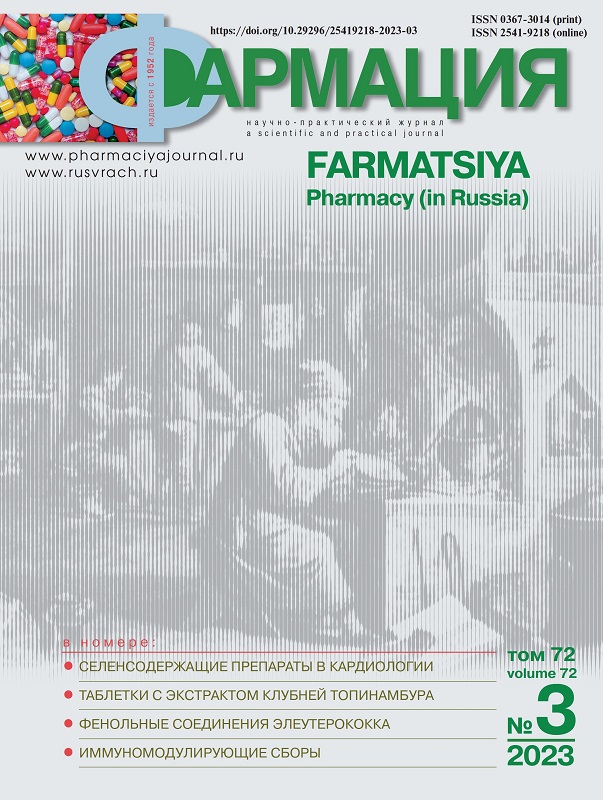Phenolic compounds content in the raw material of Eleutherococcus senticosus Rupr. et Maxim
- Authors: Komarova A.A.1, Stepanova T.A.1, Prokopiev I.A.2,3, Mechikova A.Y.1
-
Affiliations:
- Far Eastern State Medical University
- Komarov Botanical Institute
- Institute for Biological Problems of Cryolithozone, Siberian Branch of the Russian Academy of Sciences
- Issue: Vol 72, No 3 (2023)
- Pages: 23-29
- Section: Pharmaceutical chemistry and pharmacognosy
- URL: https://journals.eco-vector.com/0367-3014/article/view/456400
- DOI: https://doi.org/10.29296/25419218-2023-03-04
- ID: 456400
Cite item
Abstract
Introduction. The object of study is Eleutherococcus senticosus, which is a pharmacologically valuable source of phenolic compounds. Natural phenolic compounds attract the attention of specialists as biologically active substances, mainly with antioxidant and antitumor effects.
Objective. Determination of the content and variability index of phenolic compounds in the underground organs of Eleutherococcus.
Material and methods. The material of the study was the rhizomes and roots of Eleutherococcus harvested in the Amur Region, the Jewish Autonomous Region, as well as in the Khabarovsk and Primorsky Territories in the period 2019–2021. The content of oxidizable substances was determined by the titrimetric method, phenolic compounds – by the spectrophotometric method. The content of individual substances was investigated using HPLC and GC-MS.
Results. According to the results of the study, the average content of oxidizable substances was 2.44%, phenolic compounds – 1.47%, with the relevant coefficients of variation 18% and 41%. The average content of eleutherosides B and E respectively was 0.20% and 0.21%, chlorogenic acid – 0.18%, caffeic acid – 0.03%. The average content of isofraxidin, protocatechuic, ferulic, feruloylquinic acids and sinapyl alcohol in the underground organs of Eleutherococcus ranged from 1.84 to 11.40 mg/100g. The coefficients of variation for individual substances ranged from 41 to 90%.
Conclusion. It has been established that the content of phenolic compounds in Eleutherococcus samples is characterized by significant fluctuations. The coefficients of variation in the content of individual substances were generally significantly higher than similar indicators for the total oxidizable and phenolic compounds. Correlation analysis revealed the presence of certain relationships in the content of phenolic substances in the underground organs of Eleutherococcus. The closest relationship was found between the amount of sinapyl alcohol and ferulic acid (r=0.9).
Full Text
About the authors
Aitalyyna Kuo Aleksandrovna Komarova
Far Eastern State Medical University
Author for correspondence.
Email: aytakom26@gmail.com
ORCID iD: 0009-0003-3017-6541
Pharmacy resident at the Department of Pharmacy and Pharmacology, Far Eastern State Medical University
Russian Federation, Muravyov-Amursky str., 35, Khabarovsk, 680000Tatyana Alekseevna Stepanova
Far Eastern State Medical University
Email: tastep01@yandex.ru
ORCID iD: 0009-0005-5352-5657
Doctor in pharmaceutical sciences, professor at the Department of Pharmacy and Pharmacology, Far Eastern State Medical University
Russian Federation, Muravyov-Amursky str., 35, Khabarovsk, 680000Ilya Andreevich Prokopiev
Komarov Botanical Institute; Institute for Biological Problems of Cryolithozone, Siberian Branch of the Russian Academy of Sciences
Email: ilya.a.prokopiev@gmail.com
ORCID iD: 0000-0001-8755-7140
PhD in biological sciences, senior researcher at Komarov Botanical Institute, leader researcher at the Institute for Biological Problems of Cryolithozone, Siberian Branch of the Russian Academy of Sciences
Russian Federation, Prof. Popov str., 2, Saint Petersburg, 197376; Lenin Ave., 41, Yakutsk, 677980Arina Yakovlevna Mechikova
Far Eastern State Medical University
Email: ar.mech@mail.ru
ORCID iD: 0009-0000-9532-1285
Student of medical faculty, Far Eastern State Medical University
Russian Federation, Muravyov-Amursky str., 35, Khabarovsk, 680000References
- Rahman M.M., Rahaman M.S., Islam M.R. et al. Role of Phenolic Compounds in Human Disease: Current Knowledge and Future Prospects. Molecules. 2022; 27 (1): 1–36. doi: 10.3390/molecules27010233
- Weng C.J., Yen G.C. Chemo preventive effects of dietary phytochemicals against cancer invasion and metastasis: Phenolic acids, monophenol, polyphenol, and their derivatives. Cancer Treatment Reviews. 2012; 38 (1): 76–87. doi: 10.1016/j.ctrv.2011.03.001.
- The State Pharmacopoeia of The Russian Federation, XIV ed. [Electronic edition]. Access mode: https://femb.ru/record/pharmacopea14 [accessed 12 February, 2023] (in Russian).
- Gerontakos S., Taylor A., Avdeeva A. Y. Findings of Russian literature on the clinical application of Eleutherococcus senticosus (Rupr. & Maxim.): A narrative review. J. of Ethnopharmacology. 2021; 278: 1–13. doi: 10.1016/j.jep.2021.114274
- Huang L., Zhao H., Huang B., Zheng C., Peng W., Qin L. Acanthopanax senticosus: review of botany, chemistry and pharmacology. Pharmazie. 2011; 66 (2): 83–97.
- Liu J. Sun Ch., Yao Ch. The research of measuring eleutheroside B, eleutheroside E and flavonoid secondary metabolites content of root of Acanthopanax senticosus by UPLC – MS /MS simultaneously. Journal of Jilin forestry science and technology. 2017; 46 (4): 7–13. doi: 10.16115/j.cnki.issn.1005–7129.2017.04.003
- Bubenchikov R.A., Klokov R.E., Sovarenko M.I. Izuchenie flavonoidnyh soedinenij travy mar'yannika serebristo-pricvetnikovogo. Farmaciya. 2017; 66 (3): 17–9 (in Russian).
- Meng X., Yu D., Yang G., Wang X. Active Ingredients in Acanthopanax senticosus Roots and Associated Ecological Factors. World Science and Technology/Modernization of Traditional Chinese Medicine and Materia Medica. 2009; 11 (3): 423–7.
- Han M., Wang L., Guo Sh., Yang Z. Syringin Content of Acanthopanax senticosus Roots and Stems in Different Population Structures. Journal of Jilin Agricultural University. 2016; 4: 434–8.
- Garsiya E.R. Farmakognosticheskoe izuchenie tatarnika kolyuchego (Onopordum acanthium L.): diss. … kand. farm. nauk. Pyatigorsk, 2021; 154 (in Russian).
- Radix et Rhizoma seu Caulis Acanthopanacis Senticosi. Pharmacopoeia of the People’s Republic of China. Beijing: People’s Medical Publishing House. 2020; 215.
- York W.S., Darvill A.G., McNeil M., Stevenson T.T., Albersheim P. Isolation and characterization of cell walls and cell wall components. Methods in enzymology. 1986; 118: 3–40.
- Standard Reference Data Program, National Institute of Standards and Technology, Gaithersburg, MD. Standard Reference Database IA. URL:http://www.nist.gov/srd/nist1a.htm
- Eleutherococcus. European Pharmacopoeia. 10th edition. Strasbourg: Council of Europe. 2019; 1423–5.
- Gmurman V.E. Teorija verojatnostej i matematicheskaja statistika. M.: Jurajt, 2022; 480 (in Russian).
- Li Q., Jia Y., Xu L., Wang X., Shen Zh. Simultaneous determination of protocatechuic acid, syringin, chlorogenic acid, caffec acid, liriodendrin and isofraxidin in Acanthopanax senticosus Harms by HPLC-DAD. Biological & pharmaceutical bulletin. 2006; 29 (3): 532–4. doi: 10.1248/bpb.29.532.
Supplementary files






